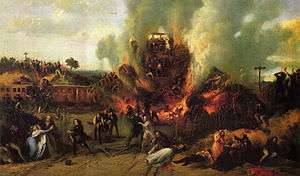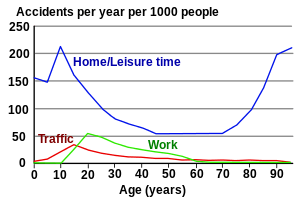Accident
An accident is an unplanned event that sometimes has inconvenient or undesirable consequences, other times being inconsequential. The occurrence of such an event may or may not have unrecognized or unaddressed risks contributing to its cause. Most scientists who study unintentional injury avoid using the term "accident" and focus on factors that increase risk of severe injury and that reduce injury incidence and severity.[1]
Types

Physical and non-physical
Physical examples of accidents include unintended motor vehicle collisions or falls, being injured by touching something sharp, hot, dropping a plate, accidentally kicking the leg of a chair while walking, unintentionally biting one's tongue while eating, accidentally tipping over a glass of water, contacting electricity or ingesting poison. Non-physical examples are unintentionally revealing a secret or otherwise saying something incorrectly, accidental deletion of data, forgetting an appointment etc.
Accidents by activity
- Accidents during the execution of work or arising out of it are called work accidents. According to the International Labour Organization (ILO), more than 337 million accidents happen on the job each year, resulting, together with occupational diseases, in more than 2.3 million deaths annually.[2]
- In contrast, leisure-related accidents are mainly sports injuries.
Accidents by vehicle

- Aviation
- Bicycles
- Sailing ships
- Traffic collisions
- Train wrecks
- Trams
Domino effect accidents
In the process industry, a primary accident may propagate to nearby units, resulting in a chain of accidents, which is called domino effect accident.
Common causes

Poisons, vehicle collisions and falls are the most common causes of fatal injuries. According to a 2005 survey of injuries sustained at home, which used data from the National Vital Statistics System of the United States National Center for Health Statistics, falls, poisoning, and fire/burn injuries are the most common causes of death.[3]
The United States also collects statistically valid injury data (sampled from 100 hospitals) through the National Electronic Injury Surveillance System administered by the Consumer Product Safety Commission.[4] This program was revised in 2000 to include all injuries rather than just injuries involving products.[4] Data on emergency department visits is also collected through the National Health Interview Survey.[5] In The U.S. the Bureau of Labor Statistics has available on their website extensive statistics on workplace accidents.[6]
Accident models
Many models to characterize and analyze accidents have been proposed,[7] which can by classified by type. Notable types and models include:[8]
- Sequential models
- Complex linear models
- Process model
- Benner 1975
- Systemic models
- Rasmussen
- Reason Model of System Safety (embedding the Swiss cheese model)
- Woods, 1994
- Non-linear models
- System accident[15]
- Systems-Theoretic Accident Model and Process (STAMP)[16]
- Functional Resonance Accident Model (FRAM) [17]
- Assertions that all existing models are insufficient[18]
Ishikawa diagrams are sometimes used to illustrate root-cause analysis and five whys discussions.
See also
General
Transportation
- Air safety
- Bicycle safety
- Car
- Automobile safety
- Traffic collision
- List of rail accidents
- Tram accident
- Sailing ship accidents
Other specific topics
References
- Robertson, Leon S. (2015). Injury Epidemiology: Fourth Edition. Lulu Books.
- "ILO Safety and Health at Work". International Labour Organization (ILO)
- Runyan CW, Casteel C, Perkis D, et al. (January 2005). "Unintentional injuries in the home in the United States Part I: mortality". Am J Prev Med. 28 (1): 73–9. doi:10.1016/j.amepre.2004.09.010. PMID 15626560.
- CPSC. National Electronic Injury Surveillance System (NEISS). Database query available through: NEISS Injury Data.
- NCHS. Emergency Department Visits. CDC.
- "Injuries, Illnesses, and Fatalities". www.bls.gov.
- A long list of books and papers is given in: Taylor, G.A.; Easter, K.M.; Hegney, R.P. (2004). Enhancing Occupational Safety and Health. Elsevier. pp. 241–245, see also pages 140–141 and pages 147–153, also on Kindle. ISBN 0750661976.
- Yvonne Toft; Geoff Dell; Karen K Klockner; Allison Hutton (April 2012). "Models of Causation: Safety". In HaSPA (Health and Safety Professionals Alliance) (ed.). OHS Body of Knowledge (PDF). Safety Institute of Australia Ltd. ISBN 978-0-9808743-1-0.
- H.W. Heinreich (1931). Industrial Accident Prevention. McGraw-Hill.
- Bird and Germain, 1985
- Gibson, Haddon, Viner
- Viner
- Svenson
- Reason, James T. (1991). "Too Little and Too Late: A Commentary on Accident and Incident Reporting". In Van Der Schaaf, T.W.; Lucas, D.A.; Hale, A.R. (eds.). Near Miss Reporting as a Safety Tool. Butterworth-Heinemann. pp. 9–26.
- Perrow, 1984
- Leveson 2004
- Hollnagel, 2004
- Dekker 2011
External links
| Wikiquote has quotations related to: Accident |
| Wikimedia Commons has media related to Accidents. |